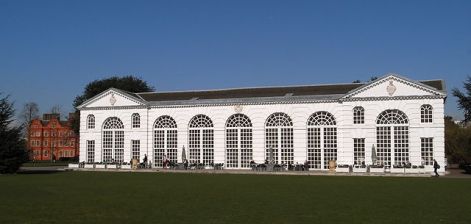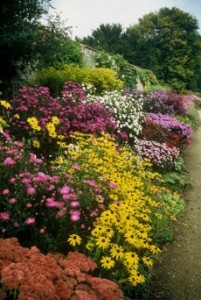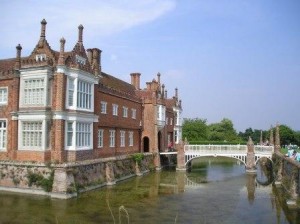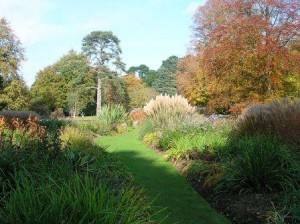
Orangery, Kew Gardens - © Patche99z
Kew Gardens are a firm favourite among tourists, the famous Royal Botanic Gardens, Kew are internationally renowned attracting many visitors from around the world each year. The gardens are located outside of central London in between Kew and Richmond in South West London, there is over 325 acres of landscaped gardens that contain herbaceous bedding, botanical glasshouses, water features, a number of historic buildings and a number of separate and distinctive gardens. The gardens have a peaceful and tranquil setting on the banks of the river Thames in the South West of London. Visitors can explore at their own leisure and learn more about all aspects of horticulture.
Overview
Kew Gardens have long been a favourite tourist attraction, located in South West London on the banks of the River Thames the gardens are well known around the world and synonymous with London's historic landscape. With more than 325 acres of gardens to explore there is plenty for visitors to see and explore here. The gardens have a long and distinguished history, the gardens have been here since the 17th century however the gardens officially became the Royal Botanic Gardens back in 1759. The gardens with their wealth of trees, flowers and plants have made a great contribution over the years to the study of economic botany, horticulture and plant diversity.
Today the gardens are highly regarded internationally and have become recognised as helping in the study and exploration of botany along with influencing landscaped gardens and architectural features in Europe and beyond. The gardens were awarded with the World Heritage Site status in 2003 in recognition to their influence and significance.
Currently there are over 25 gardens for visitors to explore at Kew, with great diversity in the Formal Gardens that range from the Aquatic Garden with over 100 species of water plants to the Secluded Garden with its tactile plants set in a compact garden to the Queen's Garden a seventeenth century style garden. The Mediterranean Garden is located at King William's Temple, the collection contains scented Mediterranean style herbs, shrubs and a variety of other plants. A visit here offers visitors an interesting experience with the different scents in the air. There is a collection of rock roses and large exotic Yuccas.
The gardens also contain a number of spectacular Glasshouses, each of these glasshouses contains different types of and examples of plants from around the world.
The Waterlily House was built in 1852, at the time it was the widest single span glasshouse in the world, designed specifically to house the giant Amazonian waterlily. It is the hottest and most humid environment found at the gardens housing topical aquatic plants.
The Palm House is the showpiece of the gardens. It was built in the 1840s and currently is home to a range of tropical trees, coconut palms, banana plants, mango trees and a variety of palms and shrubs. There are also a number of plants of economic significance grown for a variety of purposes.
The Temperate House contains an impressive collection of sub tropical plants including American plants including salvias and brugmansias and an Australian collection that includes grass trees and the world's largest indoor plant, the Chilean wine-palm.
Kew Palace is the oldest building that survives in the Royal Botanic Gardens. The building is from the 17th century and was once the home of King George III and Queen Charlotte, there are a number of items from the Royal Family on display at the palace. Kew Palace is the smallest among the royal palaces in contrast to the larger palaces and much more compact, it is a four storey brick house built by Samuel Fortrey. The Palace was bought by King George III in 1781 to house his family and has since become a permanent home for the Royal Family. In recent years the Kew Palace has undergone restoration and is now open to the public to view.
For children there is the Climbers and Creepers, an interactive botanical play zone. Designed for children from 3 to 9 years, it aims to show children the advantages of learning more about plants and how they are important to people and animals in a fun way through interactive games and learning.
Visitors to Kew have the option to join a guided tour if they wish, follow one of the themed trails to explore themselves or simply go around to see and explore more about the gardens at their own pace. A visit here offers an enjoyable day out for the whole family with activities for children in the Climbers and Creepers. The tranquil location and pleasant surroundings of the extensive gardens offers great scenery and a relaxing environment.
How To Get There
The Royal Botanic Gardens, Kew is located on the banks of the River Thames in Surrey. The site is approx 6 miles from central London. The site is accessible by both car and public transport:
By Car:
Whilst the majority of visitors are likely to come to the Gardens via public transport given it is quite convenient and practical to do so. It is however possible to go by car too.
Kew Gardens is signposted from the major local roads. The South Circular (A205) passes by the north-east corner of Kew Gardens at the junctions with the A307 and A305.
If you are travelling from the western side on the M4 motorway, exit at junction 2 and take the A205 to the right at Chiswick roundabout and take the A205 over the Kew Bridge and towards the gardens.
If you are travelling from the North Circular (A406), drive until the Chiswick roundabout and take the A205 towards the gardens.
For those with Satellite Navigation systems the postcode is TW9 3AB
A car park is located near the Brentford Gate, it has limited parking for approx 300 cars. The cost is £5 for all day parking around the year.
There are a number of dedicated parking bays for disabled drivers, parking here is free at all times for those eligible to park here.
There is free car parking available on Kew Road (A307) after 10.00 each morning.
By Train:
Kew Gardens Station offers connecting services, trains from Stratford go to Kew Gardens station.
There are train services from London Waterloo station to Kew Bridge station, which is approx a 10 minute walk from the gardens.
By Tube (Underground):
Using the Underground to get to the site is possibly the most convenient way to get here. The closest Underground station is Kew Gardens Station on the District Line, the line services the stations at London Victoria, Westminster and Embankment in central London among others. The service with a destination of 'Richmond' stops at Kew Gardens station.
By Bus:
There are a number of local bus routes that service the gardens and the surrounding areas. Bus Route numbers 65 from Ealing Broadway station to Kingston via Kew Green & Kew Road offers services every 10 to 12 minutes.
Bus number 237 from Hounslow to Shepherds Bush Green via Kew Bridge offers services every 10 to 15 minutes.
Bus number 267 from Hampton Court to Hammersmith via Kew Bridge offer services every 12 to 15 minutes.
Bus number 391 from Richmond to Kew Gardens station offer services every 12 to 20 minutes.
By Riverboat:
Westminster Passenger Services Association offers services between Westminster and Kew and further. The services usually run from April until October. The route includes stops at Westminster, Putney, Kew, Richmond and Hampton Court.
Contact Details
Address:
Royal Botanic Gardens
Kew
Richmond
Surrey
TW9 3AB
United Kingdom
Telephone: +44 (0)20 8332 5655
Fax: +44 (0)20 8332 5197
Website: Royal Botanic Gardens, Kew
Facilities and Information
Further Information:
Kew Gardens:
Mon to Sun: 09.30 to 17.30 (Early Feb to late Mar)
Mon to Sun: 09.30 to 18.30/19.30 (April to end of Aug)
Kew Palace:
Mon to Sun: 10.30 to 16.15
Glasshouses & Galleries:
Mon to Sun: 09.30 to 17.00 (Early Feb to late Mar)
Mon to Sun: 09.30 to 17.30 (April to end of Aug)
Rhizotron and Xstrata Treetop Walkway:
Mon to Sun: 09.30 to 17.00 (Early Feb to late Mar)
Mon to Sun: 09.30 to 17.30/18.30 (April to end of Aug)
Climbers and Creepers:
Mon to Sun: 10.30 to 17.00 (Early Feb to late Mar)
Mon to Sun: 10.30 to 17.30 (April to end of Aug)
Admission Prices:
Kew Gardens:
Day entry:
Adults: £13 approx, Concessions: £12 approx, Children under 17: Free (when accompanied by an adult)
Registered blind & partially-sighted visitors : Free
Kew Palace:
Adults: £5 approx, Concessions: £4.50 approx, Children under 17: Free (when accompanied by an adult)
Map
View Larger Map
For Local Search and Directions see: Kew Gardens Map
Tips & Other Considerations
There may be some variations on the opening hours of the various attractions at the site depending on the time of year and other factors. Visitors are advised to double check each attraction they wish to see before going & avoid disappointment.
When travelling follow travel safety advice & always remain vigilant, alert and aware of your surroundings and environment. Ensure your belongings in particular your wallet/purse and valuables are hidden away from public view (especially at tourist attractions & places with crowds). If you have a bag try to use a shoulder bag with a good quality, strong strap, that is put across your shoulder not on your shoulder making it more difficult for anyone to take your bag.
If you are travelling by car to Kew Gardens ensure you are well prepared with maps and Sat Nav to aid your journey, particularly if you are not familiar with the local area and roads. There may be one way roads, traffic control measures and it is recommended drivers exercise caution and drive safely. Use the Route & Journey Planner for useful door to door directions for car and public transport journeys.
If you are looking for local car parking close to the Gardens, ensure you fully understand the rules, regulations & charges for car parks and street parking before you park your car. Car parking rules are rigorously enforced and any infringement of the rules can result in vehicles being fined, clamped or towed away. The rules & regulations can be complex and confusing if you are not sure it is wise not to park there.
If you are travelling by public transport, check for service updates prior to beginning your journey for any delays, disruption or cancellations to services that may impact on your journey. Ensure you have the service timetables for the trains, buses and coaches. Remember when the last services are and ensure you make it to the train/bus/coach stops well in time to avoid missing the service.
Disclaimer: The information given in on this website is given in good faith and to the best of our knowledge. If there are any discrepancies in no way do we intend to mislead. Important travel details and arrangements should be confirmed and verified with the relevant authorities.




